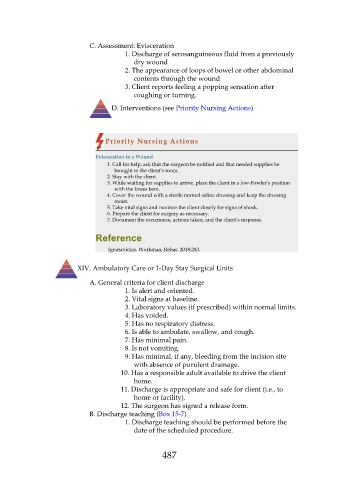Page 487 - Saunders Comprehensive Review For NCLEX-RN
P. 487
C. Assessment: Evisceration
1. Discharge of serosanguineous fluid from a previously
dry wound
2. The appearance of loops of bowel or other abdominal
contents through the wound
3. Client reports feeling a popping sensation after
coughing or turning.
D. Interventions (see Priority Nursing Actions)
Priority Nursing Actions
Evisceration in a Wound
1. Call for help; ask that the surgeon be notified and that needed supplies be
brought to the client’s room.
2. Stay with the client.
3. While waiting for supplies to arrive, place the client in a low-Fowler’s position
with the knees bent.
4. Cover the wound with a sterile normal saline dressing and keep the dressing
moist.
5. Take vital signs and monitor the client closely for signs of shock.
6. Prepare the client for surgery as necessary.
7. Document the occurrence, actions taken, and the client’s response.
Reference
Ignatavicius. Workman, Rebar. 2018;283.
XIV. Ambulatory Care or 1-Day Stay Surgical Units
A. General criteria for client discharge
1. Is alert and oriented.
2. Vital signs at baseline.
3. Laboratory values (if prescribed) within normal limits.
4. Has voided.
5. Has no respiratory distress.
6. Is able to ambulate, swallow, and cough.
7. Has minimal pain.
8. Is not vomiting.
9. Has minimal, if any, bleeding from the incision site
with absence of purulent drainage.
10. Has a responsible adult available to drive the client
home.
11. Discharge is appropriate and safe for client (i.e., to
home or facility).
12. The surgeon has signed a release form.
B. Discharge teaching (Box 15-7)
1. Discharge teaching should be performed before the
date of the scheduled procedure.
487

